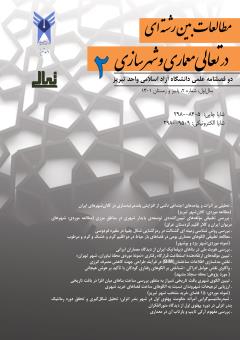بررسی هویت ملی در بناهای دیپلماتیک ایران از دیدگاه معماران ایرانی
محورهای موضوعی : معماری
نسیم نجفقلی پور کلانتری
1
,
شبنم اکبری نامدار
2
![]()
1 - استادیار گروه معماری، واحد تبریز، دانشگاه آزاد اسلامی، تبریز، ایران.(نویسنده مسئول) n.najafgholipour@iaut.ac.ir
2 - استادیار گروه معماری، واحد تبریز، دانشگاه آزاد اسلامی، تبریز، ایران.
کلید واژه: فرهنگ, معماری, هویّت ملّی, بناهای دیپلماتیک ایران,
چکیده مقاله :
دیپلماسی یکی از عوامل مهم نشاندهندهی هویت یک حکومت است که تاریخچهای دیرین و به قدرت تاریخچهی شهرها دارد. بناهای دیپلماتیک و خصوصاً سفارتخانهها نمایندهی یک کشور بیگانه در پایتخت و یا در شهرهای مهم کشور میزبان هستند که زمین آنها خاک کشور بیگانه محسوب میشود و دولتها در امور داخلی آنها دخالت نمیکنند. مهمترین عامل در طراحی چنین فضایی، تصویر و مفاهیمی است که کشور میهمان میخواهد در کشور میزبان ارائه کند. ضرورت پرداخت به این موضوع ازآنجهت حائز اهمیت است که از یکسو مسائل سیاسی و اجتماعی را تحت شعاع قرار داده است و از سوی دیگر از بعد فرهنگی نیز میتواند کمک فراوانی را جهت معرفی هویت معماری ایرانی ارائه نماید. لذا هدف از تحقیق حاضر، بررسی عوامل تأثیرگذار بر هویت ملی در بناهای دیپلماتیک در ایران از دیدگاه معماران ایرانی است. این پژوهش سعی داشته است با فرض اینکه ایجاد حریم و حس امنیت مؤثرترین متغیر تأثیرگذار بر هویت ملی در بناهای دیپلماتیک است، به این سؤال پاسخ دهد که چه عواملی بر هویت ملی در بناهای دیپلماتیک در ایران از دیدگاه معماران ایرانی تأثیرگذار هستند؟ جهت تجزیهوتحلیل اطلاعات پرسشنامه از ضریب همبستگی اسپیرمن برای تعیین سهم هر یک متغیرها بر هویت ملی در بناهای دیپلماتیک از روش تحلیل رگرسیون چندمتغیری با استفاده از نرمافزار SPSS استفاده شده است. نتایج این پژوهش حاکی از آن است که هویت ملی در معماری بناهای دیپلماتیک ایران وجود دارد. فرهنگ ملی در معماری بناهای دیپلماتیک ایران وجود دارد. همچنین متغیر هماهنگی با معماری مبدأ و مقصد بیشترین تأثیرگذاری را بر هویت ملی بناهای دیپلماتیک دارد. هماهنگی طرح با زمینه، دومین متغیر تأثیرگذار بر هویت ملی بناهای دیپلماتیک است. درنهایت گشایش و دعوتکنندگی فضا و امنیت در رتبه سوم تأثیرگذاری بر هویت ملی بناهای دیپلماتیک قرار دارند.
Diplomacy is one of the important factors showing the identity of a government, which has a long history and is as strong as the history of cities. Diplomatic buildings and especially embassies represent a foreign country in the capital or in important cities of the host country, whose land is considered the territory of the foreign country and governments do not interfere in their internal affairs. The most important factor in designing such a space is the image and concepts that the guest country wants to present in the host country. The need to address this issue is important because on the one hand it has brought political and social issues under the spotlight and on the other hand it can provide a lot of help to introduce the identity of Iranian architecture. Few architects are aware of the uses, technical needs, physical characteristics and features of these buildings. While these buildings are very attractive from the point of view of the specialized discussion of design due to their complexity and dealing with different nationalities and cultures. On the other hand, we know that most countries pay attention to the architecture of their agencies abroad, and their design is a good opportunity to improve the quality of architecture in terms of design, technical specifications, and the project and building management process. Although diplomatic relations between governments date back to ancient times; But new diplomacy and especially embassies have a history of several hundred yearsIn today's world, the relations between people and governments are very extensive, the body of history is tired of wars and conflicts, today peace, tranquility and dialogue are the cries of nations, and the embassy is a place for this dialogue, the design of the embassy , design for speaking and listening in this big global village. In the dialogue between the nations, architecture as an objective and permanent manifestation, a window to discover the elements that have passed on the nations throughout history. Therefore, the purpose of this research is to investigate the factors affecting national identity in diplomatic buildings in Iran from the perspective of Iranian architects. This research has tried to answer the question, assuming that creating privacy and a sense of security is the most effective variable influencing national identity in diplomatic buildings, what factors influence national identity in diplomatic buildings in Iran from the perspective of Iranian architects? In order to analyze the questionnaire data, Spearman's correlation coefficient was used to determine the contribution of each variable on national identity in diplomatic buildings, using multivariate regression analysis method using SPSS software. The results of this research indicate that national identity exists in the architecture of Iran's diplomatic buildings. National culture exists in the architecture of Iran's diplomatic buildings. Also, the variable of coordination with the architecture of origin and destination has the greatest influence on the national identity of diplomatic buildings. The coordination of the plan with the context is the second influencing variable on the national identity of diplomatic buildings. Finally, openness and inviting space and security rank third in influencing the national identity of diplomatic buildings.
_||_


